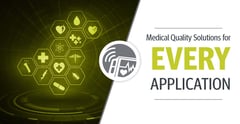
Key Takeaways: What You will Learn About Medical Manufacturing
- ► Medical device manufacturers must embrace modular production, AI integration, and digital platforms to stay competitive. These technologies support faster development, agility, and overall product quality.
- ► Reshoring and strengthening supply chains help manage global disruptions. This increases reliability for on-time delivery and reduces dependency on international networks.
- ► In low-volume, high-mix environments leveraging automated test systems and off-the-shelf hardware reduces non-recurring engineering (NRE) costs, speeds up production, and simplifies compliance.
- ► Manufacturers must prioritize cybersecurity and maintain robust documentation to meet evolving global regulations and protect patient data.
- ► Circular manufacturing and 3D printing are reducing environmental impact. This is key to meet the growing demands for greener, patient-specific solutions.
Medical device manufacturing is entering a transformative era where innovation and efficiency are no longer optional, they’re essential. As we look ahead, the industry is being shaped by significant advancements, evolving regulations, and a growing demand for smarter and sustainable products. Companies that embrace these changes will be the ones positioned to lead in this competitive market.
The Future of the Medical Device Industry
The future of the medical device industry requires the ability to innovate while maintaining manufacturing efficiency and regulation requirements. Emerging medical device trends such as AI integration, modular production, and digital platforms are redefining how products are designed, tested, and delivered. Staying ahead means focusing on technologies that support adaptability and compliance, while also prioritizing patient outcomes.
12 Trends Shaping Medical Device Manufacturing in 2026
- Supply Chain Resiliency and Reshoring
- Modular Manufacturing for Agility
- Effective Documentation and Regulatory Adaptability
- Leveraging Off-the-Shelf Testing Hardware
- Software Adaptability and Revalidation Efficiency
- Automation and Robotics in Low-Volume Production
- 5G and Connectivity for Real-Time Data
- Model-Based Testing and Digital Twin Simulation
- Cybersecurity in Connected Devices
- Workforce and Recruitment Challenges
- Data Analytics, AI and Machine Learning
- Collaboration and Standardization Across Teams
1. Supply Chain Resiliency and Reshoring
Reshoring and building resilient supply chains are critical to mitigating disruptions and ensuring reliable product delivery. Manufacturers are increasingly localizing operations to reduce dependency on unpredictable global networks.
2. Modular Manufacturing for Agility
Modular manufacturing promotes agility by allowing developers and manufacturers to quickly adapt to new product lines. This approach supports scalable production (both up and down) and faster time-to-market, especially for low-volume, high-mix medical devices.
3. Effective Documentation and Regulatory Adaptability
Organized documentation and clear regulatory strategies are essential for navigating complex compliance requirements. Streamlining IQ/OQ/PQ protocols helps manufacturers prepare for any audit and reduce delays.
4. Leveraging Off-the-Shelf Testing Hardware
Using off-the-shelf testing hardware accelerates development and reduces costs. Averna offers a range of off-the-shelf products and platforms to reduce NRE and accelerate timelines.
5. Software Adaptability and Revalidation Efficiency
Software adaptability is key to maintaining compliance and performance across device updates. Efficient revalidation processes ensure that changes don’t compromise safety or functionality in addition to causing manufacturing delays.
6. Automation and Robotics in Low-Volume Production
Automated test solutions and robotics are revolutionizing low-volume production by improving precision and repeatability. For example, Averna’s vision and optical inspection systems enhance quality control while reducing manual labor. Along with the FDA’s increased scrutiny of manual inspections, automated inspection of medical devices have significantly reduced waste and unnecessary scrapping as well.
7. 5G and Connectivity for Real-Time Data
5G connectivity enables real-time data exchange between devices, systems, and users. This delivers faster diagnostics, the option of remote monitoring, and predictive maintenance. These features are all vital for modern medical device delivery and to remain competitive.
8. Model-Based Testing and Digital Twin Simulation
Digital twin simulation and model-based testing allow manufacturers to validate designs virtually before physical production. This reduces costs (and waste) significantly, avoiding unnecessary hardware. Additionally, they speed up development, and support continuous improvement in real-time.

9. Cybersecurity in Connected Devices
Cybersecurity is a growing concern as medical devices become more connected. Protecting patient data and device integrity requires robust encryption, penetration testing, secure firmware, and proactive threat monitoring.
10. Workforce and Recruitment Challenges
Recruiting and retaining talent remains a challenge. Companies must invest in training and create attractive compensation packages to manage the loss of expertise and meet industry demands.
11. Data Analytics, AI and Machine Learning
AI and machine learning are transforming how manufacturers analyze test data and optimize performance. Tools like Proligent™ Cloud provide actionable insights that drive smarter decision-making.
12. Collaboration and Standardization Across Teams
Cross-functional collaboration and standardized processes are vital for accelerating innovation. This ensures that everyone across the board is speaking the same language. Shared frameworks, like Averna’s reusable test building blocks promote consistency, reduce NRE and reduce development time.
Additional 2026 Innovations Reshaping MedTech
AI Wearables and Digital Health Platforms
AI-powered wearables and digital health platforms are expanding the scope of patient care. These technologies enable continuous monitoring, personalized treatment, and data-driven diagnostics resulting in reliable data for proper diagnoses.
3D Printing and Personalized Manufacturing
3D printing is enabling personalized manufacturing of implants and prosthetics. Digital scans of a patient’s body are used to design prosthetics that match their unique anatomy. This leads to better fit, comfort, and functionality compared to traditional mass-produced devices. This innovation supports patient-specific solutions and reduces waste in production.
Circular Manufacturing Practices
Circular manufacturing promotes sustainability by reusing materials and minimizing the environmental impact. Unlike traditional linear manufacturing (make → use → dispose), circular manufacturing focuses on designing systems that enable reuse, repair, remanufacturing, and recycling. It aligns with the growing pressure for greener practices in the medical device sector.
Medical Device Industry Challenges in 2026
• Regulatory complexity is growing through stricter compliance across global markets.
• Supply chain risks increase due to ongoing disruptions, shortages, and tariffs.
• Cybersecurity threats are always present with a growing vulnerability through connected systems.
• Talent shortages are growing with a loss of expertise and competitive recruitment.
• The demand for greener manufacturing changes practices for improved sustainability.
Averna helps overcome these challenges with deep expertise in medical equipment testing, test automation, and validation. Whether it’s streamlining compliance, accelerating product development and manufacturing or enhancing product quality, Averna is a trusted partner in navigating industry complexities.

Building Future-Ready Medical Device Manufacturing with Averna
To build future-ready medical device manufacturing, companies are outsourcing test and quality processes to leverage best practice experiences. Averna’s automated test equipment, visual inspection systems, and test data analytics tools empower manufacturers to meet evolving demands with confidence.
Contact Averna to learn more about how MedTech leaders will thrive in 2026 and beyond.
--
By Matthew Thompson
Engineering & Sales Manager – Strategic Initiatives
You may also be interested in…
Test for the medical industry is a wide world of technologies. See how experience can tackle any quality challenge.
Get in touch with our experts or navigate through our resource center.



